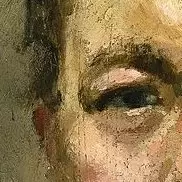Aside
For an extra boost to your enjoyment, consider listening to (Rimsky-Korsakov 2nd Symphony, Antar, movement 1: Vengeance)[https://youtu.be/Qd80g7wJWuQ?si=aZoRQ8PcU3_9OR_c]. This was the music that the artist listened to as he created the piece.
Ivan the Terrible and his son
A very sad piece indeed. Ivan the terrible’s mental illness came to a horrible climax one night when he saw his son’s pregnant wife walk by in a nightgown that exposed her under garments. Blind with rage, he struck his son in the head fataly.
The painting depicts Ivan the Terrible, stricken with grief and anguish as his son dies. The son, in tears, forgiving his father in some cosmic understanding as he lay dying.
On the surface, an example of how mental illness, left to take more and more control, can result in horrible consequences.
However, looking at the dates; the event occurred about 300 years before the painting was created. Why?
The political environment
The painting is an allegory of the assassination of Alexander II. Or rather the atrocity of the action itself and the consequences.
A group of far-left terrorists, bent on removing the autocratic tsarist government, killed A2 with a bomb in 1881; influenced by “Propaganda by the Deed,” hoping it would spark a revolution.
The painter not only witnessed the assassination, but also the hanging a few months later of the men who committed the act. He was horrified by the violence, he called them horrors of the contemporary world.
Aftermath
The act of terrorism failed and it would not be for another nearly 40 years, when things had gotten so bad and the tsars so weak that the Bolsheviks were able to succeed and establish a Soviet Republic, but only after killing basically everyone that knew how to do anything: Doctors, Lawyers, Farmers, etc. Leaving the country in tatters and the government free to be run by one person, who would go on to commit awful such atrocities that it made the whole history of the tsars look like childs play in comparison.


This is the last paragraph of your source:
So Russia went Soviet in 1917, so your source I think actually might prove my point more. But I’m sorry my words offended you, that was not my intent. I just wanted to talk about some art I thought was beautiful and sad. I hope you can look past what you perceive to be my errors and appreciate how much work I put into researching and writing that. I hope the wind is at your back, Professor.